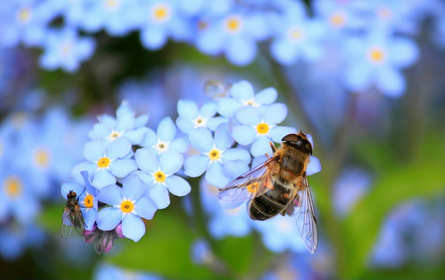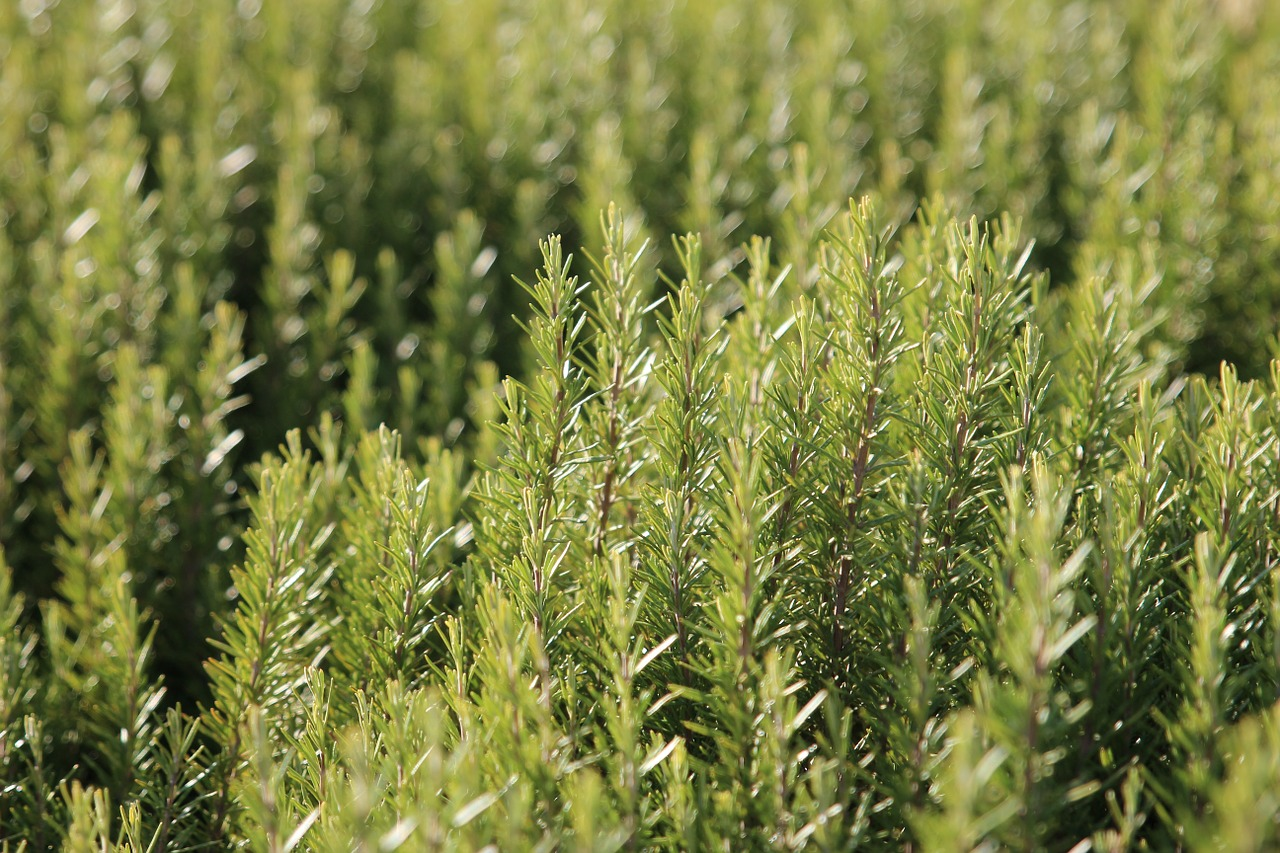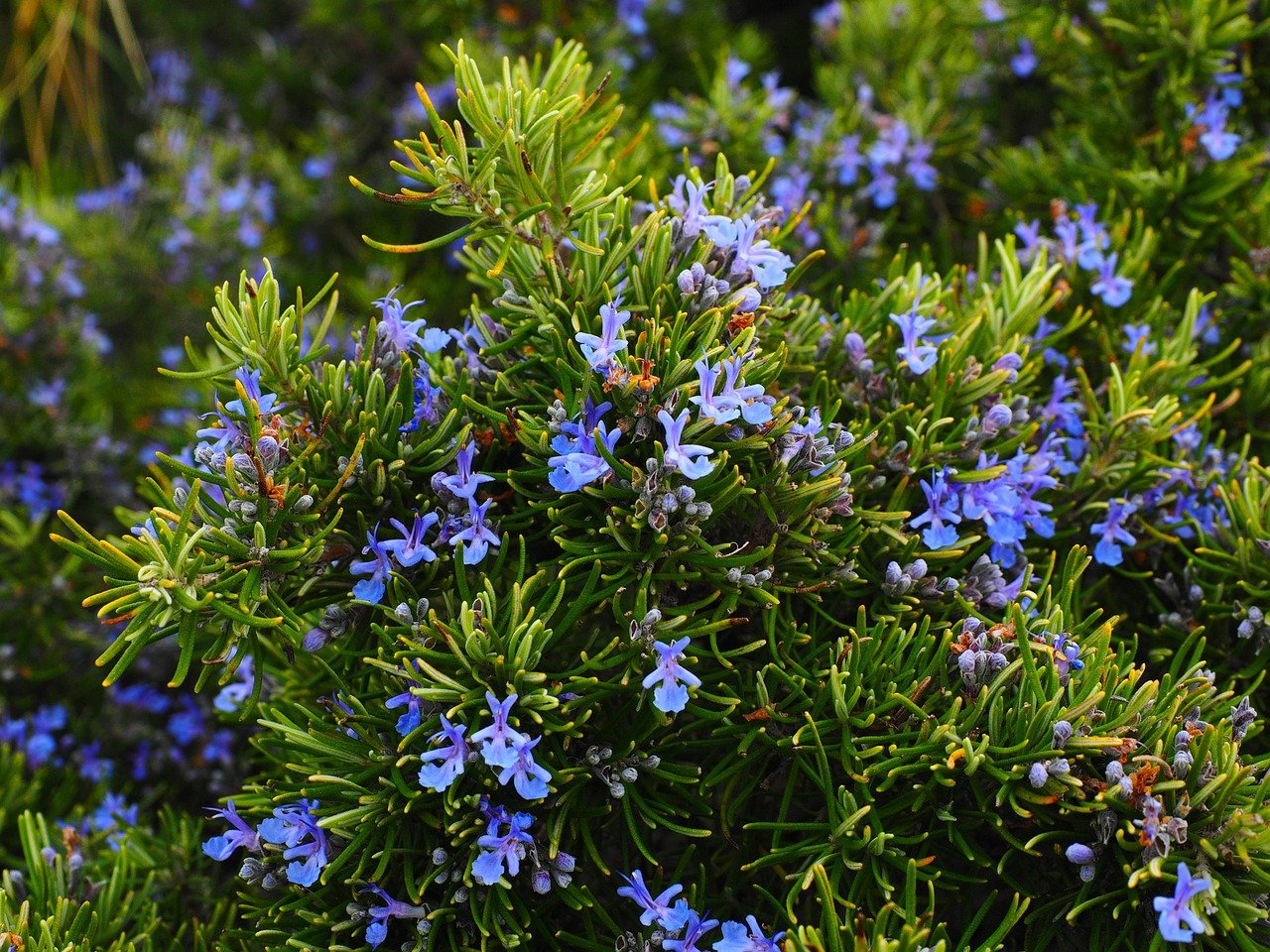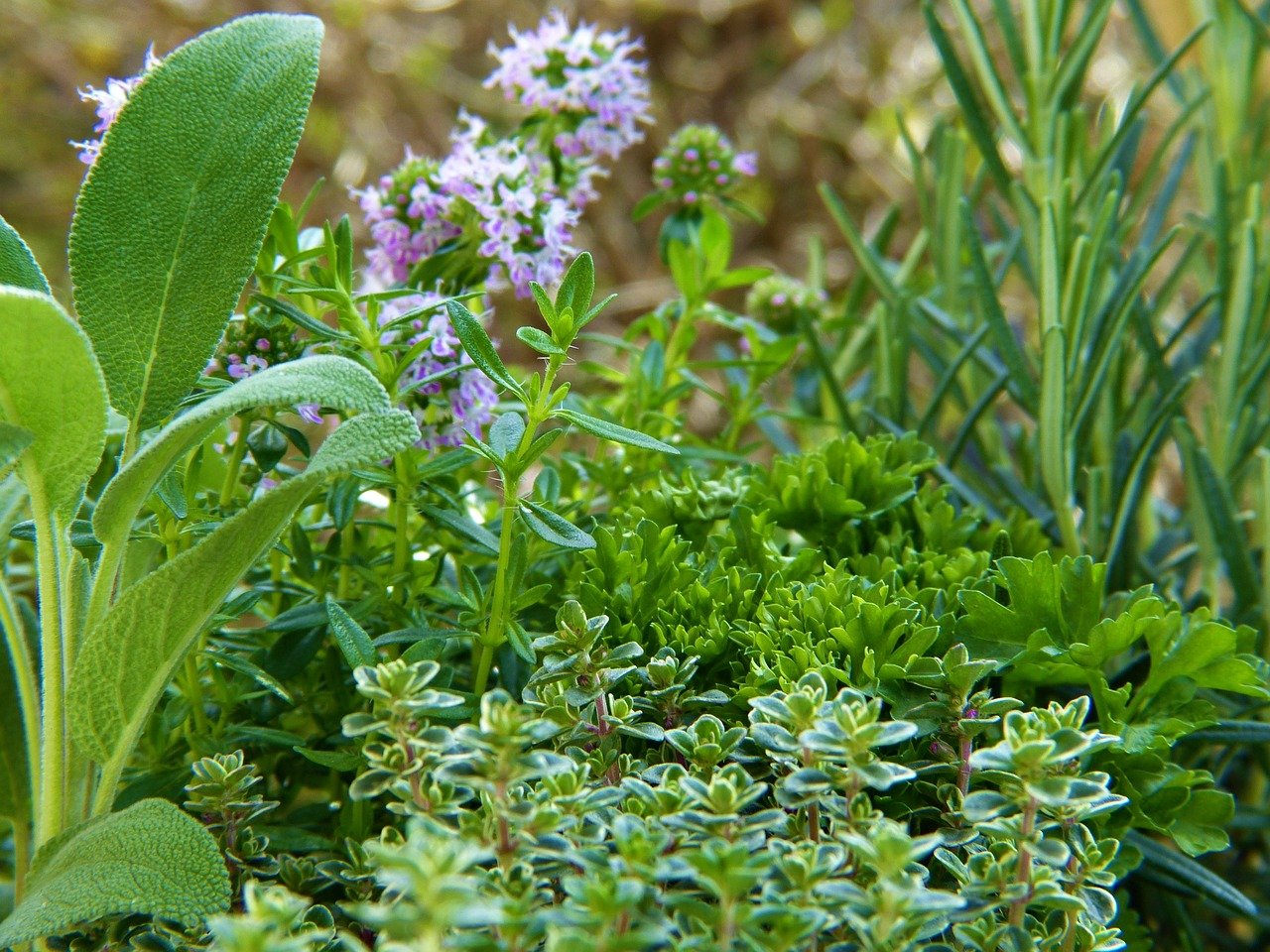
Biodiversity & Wildlife Conservation
Bee-friendly plants: Flowers, Trees & Co.

The undemanding rosemary plant is a real eye-catcher in any garden with its beautiful flowers and aromatic leaves. The leaves contain valuable ingredients and can be used fresh or dried. In our latitudes, it can be grown in the garden and in a pot. You can find out how to plant rosemary and what to look out for when caring for it in this article.
Rosemary (Rosmarinus officinalis) is a classic Mediterranean culinary and medicinal herb. It belongs to the Lamiaceae family. Rosemary blooms from March to around the beginning of May and you can admire its beautiful blue-violet to pink-white flowers, which attract numerous insects and provide them with food. The evergreen, bushy semi-shrub grows as a perennial and can reach heights of up to two meters, depending on the variety and location.
In its native country, rosemary grows in barren, stony landscapes. For this reason, it prefers moderately dry, well-drained soils, which may also be calcareous. It is well adapted to drought and accustomed to plenty of sun and warmth. For this reason, you should choose a warm, sunny spot with loose soil that cannot become waterlogged. Rosemary can be grown both in pots and in the garden. However, some varieties are only partially hardy, so growing them in pots is better. You can then simply move the shrub to a warmer place to overwinter.

From May it will be warm enough and the rosemary can be planted out in the garden. Give your rosemary plant enough space: the planting distance is 40 cm and the row spacing 50 cm. As rosemary is very vigorous, the more space the better. In its native country, there are sometimes 2 m high hedges of rosemary.
Rosemary can be successfully grown in pots, which is particularly practical for balcony and patio gardeners or in regions with harsh winters. Size is a decisive factor when choosing a pot, as rosemary needs sufficient space for its roots to grow. A good rule of thumb is to choose a pot with a diameter of at least 30-40 cm and a similar depth to give the root system enough room to spread out. Make sure that the pot has sufficient drainage holes to prevent waterlogging. Growing rosemary in a pot requires a little more attention in terms of watering and fertilizing, but it also allows better control over the growing conditions and makes it easier to overwinter the plant.
You should prepare the soil so that the semi-shrub feels at home. Soil that is too heavy should be mixed with sand and gravel, soil that is too light with a little compost. Rosemary plants that are planted directly in the garden benefit from lean soil, so they take root faster and more reliably. The same applies to growing in a pot: use a herb soil that is as low in nutrients as possible and make sure that the water can always drain away well.
Rosemary is a good neighbor in the vegetable patch as it contains many strongly scented essential oils that keep pests away from the patch. It is also a fairly robust plant. But only as long as it has good growing conditions. As rosemary requires very little water, unlike most vegetable plants, it is better suited to mixed cultivation with other herbs. In a herb bed, rosemary also attracts beneficial insects to your garden and provides valuable food and habitat. You can find out which plants are good and bad neighbors for rosemary in the following table.
| Good neighbors | Bad neighbors |
|---|---|
| Basil | Chives |
| Blackberry | Jerusalem artichoke |
| Carrots | Lovage |
| Coriander | Onion |
| Lavender | Turnip |
| Marigold | |
| Oregano | |
| Sage | |
| Thyme |
Our tip: To grow as many herbs as possible in a space-saving way, it is a good idea to create a herb spiral. This allows you to create different zones in which herbs from different locations can grow.
To give you an idea of what a herb spiral with rosemary and other herbs could look like, we have prepared some digital bed plans for your herb snail. Maybe there's something for you!
Our tip: You can read about the other benefits of mixed cultivation in the herb bed here. You can also find a table with an overview of which herbs go well together.

With our bed planner, you can easily plan a colourful mixed crop. Good and bad neighbours are displayed directly and you get tips on crop rotation!
Plan your bed nowYoung rosemary plants in particular are very sensitive to the cold and must be grown in advance on the windowsill. The small seeds can be sown from mid-March. As rosemary is a light germinator , they are only lightly covered with soil and then moistened regularly. Germination can now take up to five weeks in a warm, bright place. Alternatively, they can be sown directly outdoors from the end of May/beginning of June. With germination temperatures between 16 and 24 °C, rosemary usually finds it relatively difficult to germinate in the garden in our latitudes. In addition, rosemary seeds do not germinate particularly reliably, so it is often easier to buy a plant from an organic grocer at the market.

Rosemary is a largely low-maintenance plant that grows healthily and vigorously with a few basic care measures. You can find out what these are below:
Regular pruning is an important maintenance measure to promote the growth and health of your rosemary. This keeps the shrub in shape and allows it to develop into a stately bush or rosemary hedge over the years. On the one hand, you can influence and direct the growth habit by pruning. It also prevents lignification caused by too much dead wood. Otherwise, it will senesce, which means that deadwood will accumulate in the bush. This makes it easier for diseases and pathogens to penetrate the plant.

It is best to prune your rosemary in spring after flowering. Rosemary flowers from the end of March to the beginning of May, depending on the variety, location and weather. After that, all shoots from the previous year should be pruned close to the ground or to the start of the woody shoot. You should leave most of the old, living wood standing and shorten a maximum of one third, otherwise you will reduce the growth of the rosemary plant. You should also remove the dead wood completely so that the bush is better aerated.
If your rosemary is not growing, this could be due to incorrect care, an unsuitable location or unfavorable growing conditions. Make sure that the location offers sufficient sunlight, as rosemary is a sun-loving plant. The soil should be well-drained and not too rich in nutrients to avoid waterlogging and over-fertilization. Rosemary prefers rather dry conditions, so it is important to water moderately and make sure that the soil can dry out between waterings. It is also advisable to protect the plant from extreme temperatures and frost. To do this, you could protect the plant with a fleece, for example. Alternatively, you can also plant rosemary in a pot that you can easily move indoors or to a sheltered spot in winter. Correct these factors to promote the growth of your rosemary and provide it with optimal conditions if it fails to grow. This also includes choosing plant neighbors next to which the rosemary likes to grow.

With your own rosemary in the garden, you can harvest fresh from the bush all year round. To do this, cut off individual leaves or entire shoot tips with a sharp knife. Only parts that do not yet have a woody stem are harvested. The leaves can either be used fresh for cooking and seasoning, dried or preserved in oil.
Rosemary is an evergreen plant and can also be grown outdoors in our latitudes with the right variety. It keeps its leaves all year round, which is why you can also harvest it in winter. However, you should be careful in extreme weather conditions or frost and it is better to refrain from harvesting so as not to damage the plant.
To successfully overwinter your rosemary, there are a few important points that you should bear in mind. First of all, it is advisable to move the plant to a sheltered place before the first frosts to protect it from cold damage. If your rosemary is growing outdoors, you can cover it with a frost protection mat or fleece to protect it from extreme temperatures.
If you are growing rosemary in a pot, it is advisable to place the pot in a cool, bright and frost-free place, such as a conservatory, garage or cool hallway. Make sure that the temperature in the winter quarters is between 5 and 10 degrees Celsius. During the winter months, it is important to water the rosemary only moderately to avoid waterlogging, which can damage the root system. Keep an eye on the moisture content of the soil and only water when it has dried out on the surface.
Despite choosing a hardy rosemary variety, you should also protect it from extreme temperatures. This is particularly recommended during longer periods of frost to keep the plants healthy and strong.
We hope you have gained a brief overview of planting rosemary, caring for it and harvesting it, and wish you every success in trying it out! If you have any questions or comments, please write to us at [email protected].
Want to get helpful gardening tips all year round and plan your own beds in the best possible way? Then register here or download the Fryd app for Android or iOS.
Fryd - Your digital bed planner
Cover picture by Samueles on Pixaybay.

Marie studied agricultural science at the University of Hohenheim. Her main focus is on ecological agriculture and permaculture. She writes articles for Fryd to educate people about ecological interrelationships and alternatives to current land use. Our current economic systems, especially in agriculture, have numerous negative effects on nature and destabilize our ecosystems. We need a great diversity in our gardens and beds again to counteract the extinction of species. Every gardener can contribute to creating and maintaining habitats and food for a wide variety of creatures. With her articles, she would like to pass on her experience in dealing with natural systems and give people the opportunity to contribute to a stable ecosystem and thus also to securing our livelihood.
Learn more
Liked 4 times
There are just 7 days between the pictures. 😱😍😍😍 The #tomatoes are stepping on the gas! And are just waiting for consistently warm temperatures. 😊


Liked 4 times
The raised bed project in my little garden is progressing folks 💪🏻 pow pow pow 🎊 Just in time for sowing season! Briefly about the start of my project : We only have a sloping area in our little garden with a decent gradient. That's why I leveled the site beforehand. To do this, I laid brick after brick on edge along the garden shed into the ground and plastered the outer edge with concrete. Why this discreetly exaggerated method? We still had bricks and concrete left over from building the patio and because I wanted it to be extra fancy, I naturally chose the most fancy method 😂. And what else do you take a vacation for🙈? But let's be honest, it's more for the look than anything else🤭. I wanted to create a visually separate area in the garden that has a straight overall surface. After also protecting the outer wall of the garden shed from moisture, it was time to level the ground and fill the area with woodchippings. These wood chips are kind of trendy for raised beds right now, aren't they? (at least according to my Pinterest algorithm 😂). The 120 x 80 raised bed frames are standard plug-in frames from the DIY store (my second home 🥰). I sanded the frames briefly, sealed them with a protective glaze and put them together. Secured with chicken wire to protect against uninvited guests and covered with bubble wrap, I'll continue with the filling today 🎊! I'm really looking forward to this point. Finally, all the garden waste that has been piling up in every free corner of the garden for weeks can be put to good use and disappear behind wooden cladding 😅. Then it will be watered and the area tilled 😬 FINALLY!!! I'll keep you up to date 🌷♥️ enjoy the sun How would you have dealt with the slope? 🤗 Are your raised beds already in place or are there still newbies like me? Ciaoi 🌷
Show 1 answer
Liked 7 times
They are still small, but hopefully they will soon be big and nutritious 😊
What is the right location for rosemary?
The ideal location for rosemary is a warm, sunny spot with moderately dry, well-drained soil.
Rosemary likes it warm and sunny. It should therefore only be planted out from mid-May, after the last frosts. You should keep a planting distance of 40 x 50 cm.
What are good neighbors for rosemary?
Good neighbors for rosemary in the flower bed include lavender, thyme, hyssop, basil, blackberry, carrots, oregano, marigold and sage. You can find out more in the article.
Which soil to use for rosemary?
Rosemary prefers light, well-drained soil - it does not like waterlogging at all. Lean soil with a high sand content is best. In a pot, it is best to use a nutrient-poor herb soil.
Rosemary is a Mediterranean herb and is not normally hardy. However, there are some varieties that can survive frosts and colder winters, such as 'Arp' or 'Hill Hardy'.